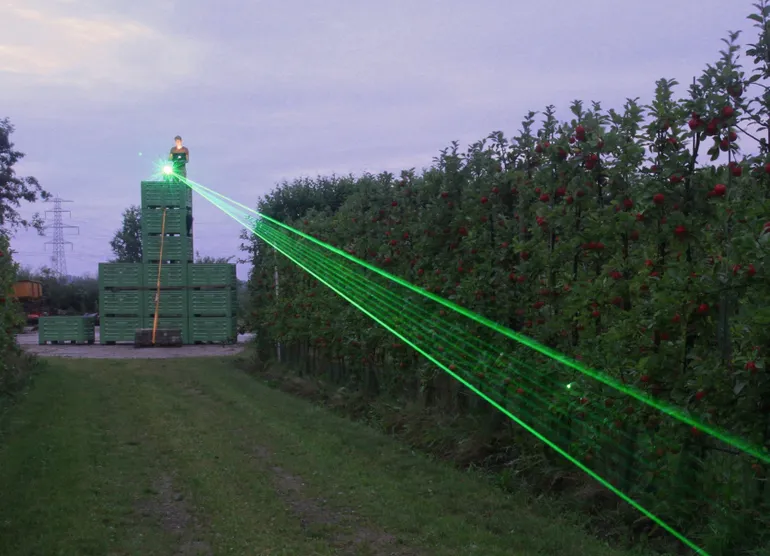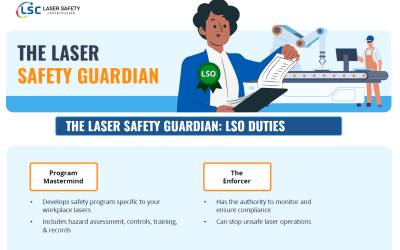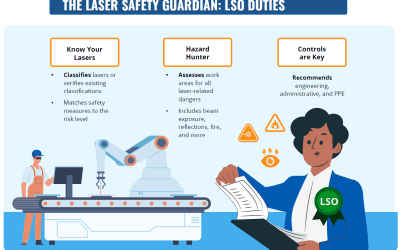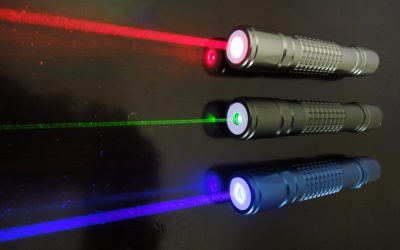When Nuisance Birds Are Out Of Control… Use Lasers
Nuisance birds are an ongoing problem in many urban areas. The conflict between birds and people competing for common food sources is an ongoing problem. It has been made worse when people and nature are growing closer together. Many cities around the world are turning to laser based solutions for bird control after other traditional methods have failed. And many agricultural producers are starting to deploy laser enable bird control solutions to protect their farms, vineyards and groves from nuisance birds and to minimize birds feeding on their crops before harvest.
New Problems with Nuisance Birds
The city of Sunnyvale, California was in the news earlier the year with several stories about their downtown having a nuisance bird problem caused by thousands of roosting crows sitting on their downtown buildings and around their parks and streets. [1] The problem has existed for generations but had become a much larger recent problem for restaurants and other downtown businesses as more people wanted to sit or dine outside during the pandemic. Crows are also known as social birds that roost communally together in large groups so moving them once they have roosted for a period becomes a much harder problem.
The city has tried several different dispersal methods over recent years, including outdoor speakers to play loud noises and mounting sunlight reflectors on the tops of buildings. Unfortunately, loud noise from the typical propane powered gun used for dispersal also affects residents and reflectors only work when the sun is shining, so both have even less impact at night when the crows are more likely to congregate. The city also experimented with using a falcon and a hawk, both having limited success. The falconry program also had a high cost; so now the city is turning to a much cheaper pilot program using a new solution; small hand held lasers to disturb the roosting crows.
Studies about Controlling Crows
A Humane Society story “What to do about crows?” [4] goes into some detail about the growing crow problem and describes some common conflicts between crows and people, and a number of behaviors that humans do that are attractive to birds. It also lists a number of common attractions people leave outside that seem attractive to crows such as waste, compost, outdoor lighting, pet food and even bird feeders for other desirable birds.
The Humane Society story points out how these create an attractive nuisance for the birds as they [crows] “are omnivores (eats both plant and animal foods) and will sometimes come to eat one food, such as insects, but then stay around or return to eat another, such as garden produce.” [4] The goal is to remove as many of the human created attractions as possible, while still making adding some randomness to the environment by cleaning up waste and covering compost to hide some of their common feeding sources. The story also goes on to point out why crows seem to be recently migrating more and more to urban locations– they very thing that makes them a growing nuisance to people– where there are typically laws preventing their hunting and how cities provide more intact tree stands conducive to roosting when compared to modern rural locations that have been groomed for agricultural uses.
The Human Society story also goes on to list some common solutions that can work together to disrupt the normal crow behavior:
- Playing recorded crow distress calls.
- Pyrotechnics (using loud noisemakers that sound like fireworks).
- Deploying lasers designed to harass birds.
- Hanging effigies (fake models) of dead crows (but never use the real thing).
These common approaches are summarized as: “Used together, each of these techniques reinforce the others to convince crows the roost location is unsafe” [4] The study finishes with a good list of public health and disease concerns to reinforce why we need to look for humane methods for bird control in urban areas, and it concludes with a good summary why using poison to thin bird flocks is not a safe or viable solution either.
Another study from the PennState Extension Service titled “Managing Urban Crow Roosts in Pennsylvania and the Northeast” [5] provides an even more detailed analysis of the crow problem and lists viable solutions.
The PennState Extension study describes the nuisance problem in detail as crows can “cause a variety of nuisance problems. Depending on where they choose to roost, there can be an accumulation of droppings on sidewalks, cars, and buildings. Bird feces on buildings and equipment can shorten their useful life and increase cleanup costs. The loud and raucous calling as birds arrive at night and depart in the predawn hours can be disturbing, and in some rare cases crows cause physical damage to the structure where they are roosting. Large roosts near airports can pose a risk to air traffic safety when crows fly to and from the roost.” [5]
The PennState Extension study outlines a plan for managing and mitigating nuisance crows:
- Establish a working group that will coordinate effort
- Develop a monitoring plan
- Review the available (or viable) management options
- Establish a limited set of no-tolerance problematic zones
- Describe on the management options to be used
- Nothing
- Public information and education
- Habitat management
- Harassment
- Consider the available workforce and coordinate efforts
- Determine the needed budget
- Keep the public informed
- Monitor the identified roosting areas
- Begin management early in the season
- Manage expectations
Also note that crows are legally protected by the federal Migratory Bird Treaty Act. [14]
Another interesting fact is that all states in the United States allow crow hunting with the exception of Hawaii. [15]
The PennState Extension study lists the following management techniques that can be attempted:
- Harassment using pyrotechnics
- Harassment using distress calls
- Harassment using low-powered lasers
- Using methyl-anthranalite as a fogging irritant
- Using effigies simulating dead crows
The PennState Extension study ends with the following note on lethal methods that “While nonlethal dispersal methods may be effective, crows may become habituated to them, because of their intelligence and tenacity. Targeted shooting of crows may help to reinforce the message that a particular location is a bad place to roost. However, it often is not a viable option in urban areas where most problems with roosting crows occur.” [5]
Both of these articles include low power lasers as a viable and safe (to the birds) solution for nuisance bird management.
A September 2003 U.S. Department of Agriculture publication, “Use of Lasers in Avian Dispersal” [18] says that lasers are “safe and effective species-specific alternatives to pyrotechnics, shotguns, and other traditional avian dispersal tools.” We will discuss effectiveness later in this article, but remember the phrase is “species-specific” as you read on for some of the reported results and what type of bird was being studied.
Solutions to Protect People and Food
Much like Sunnyvale, many other towns across the country and around the world are investigating using manual or automatically oriented lasers to disturb roosting birds from locations they are deemed a nuisance. A blog from the Bird Control Group [3] notes that in Western England shopkeepers and other residents have changed their tactics from using high pressure water hoses to manually pointed laser devices to scare off birds from their buildings.
This same approach for using lasers to keep birds away from outside areas where people want to be also applies to keeping birds away from delicate growing food and preventing them from eating mature fruit. Some recent success using automated bird dispersal away from growing blueberries in Oregon is noted in stories from NPR [13] and ZDNet [2] that highlight the use of Bird Control Group’s AgriLaser product. [7] The stories noted the grower had up to 25% losses in previous years from flocks of thousands of starlings and noted “birds like the American Robin and European Starling cost the state of Oregon over $11 million in lost blueberry harvest last year.” [12]
The grower states that the solution is “based on some interesting behavioral science. The laser bird deterrent technology takes advantage of a bird’s natural instincts. Birds perceive an approaching laser beam as a predator and take flight to seek safety.” [2]
How Effective are Laser based Systems?
Bird perceive the green laser light best and therefore the bird dispersal is most effective using a wider beam. A Margo Supplies blog [17] summarizes this behavior: “Many bird species associate this light with predator-like behavior and flee when exposed to the visible light pattern. The most effective bird lasers produce a wide beam, as opposed to a narrow beam in the conventional laser pointers. Green beams generally seem to produce the best results.”
Crucially, birds don’t become habituated to the green dots, meaning there’s no loss of effectiveness over time.
A study from Wageningen University [11] in the Netherlands showed high success rates using lasers for deterrence of migratory ducks. The methodology used a “laying hen farm has regularly been infected with avian influenza in the past” as a study site having a nuisance history that was impacting the food supply. [11] The laser itself was from the Bird Control Group [15] and was installed to a 6 meter high mast in a free range area connected to the study area of a barn and an approximately 3 plus acre field. The study area was monitored using eight wide-angle video cameras installed on 4 meter high poles to record visits of wild birds. The results were surprising and showed that “when the laser was used, almost no wild ducks visited the range (99.7% prevention). In addition, visits of other wild birds to the range between sunrise and 10 am were significantly reduced (> 96% prevention) by the laser.” [11]
Another European Union CORDIS research study [12] also using the Bird Control Group AVIX Autonomic Mark II had results showing it “that harmlessly scares away over 80 % of birds in a designated area.” [15] This study was based on ?? birds.
An earlier University of Nebraska – Lincoln study [6] in 2002 using the Feather Light Technologies Avian Dissuader [16] measured the bird responses using hand held laser devices in various tree roosting environments frequented by crows. The study found that “At all roosts crows reacted to the laser; in nearly half (49%) of the treatments all crows responded by immediately flying out of the roosts (table 2). At 44% of the roosts the majority of crows (>50% but <100%) flew out immediately. In all cases crows that did not take flight immediately eventually left the roosts as treatment continued. At 84% of the roosts the crows left without vocalizing and at 95% of the roosts the crows flew directly away without circling overhead.” However, this study also notes (our emphasis) “In all cases crows returned to the roosts within a 15-minute period.” and the study summarized the longer term results were not effective.
The Margo Supplies blog [17] cited earlier, while not scientific, summarizes an alternative approach that may improve the results: “An effective technique is to repeatedly treat roosting sites at dawn and dusk, this gives birds time to find alternative roosts outside your control area. Diurnal birds will typically not flee a roost area in full dark, no matter how much pressure you put them under so it is important to begin laser treatment as soon as they return back to their roost.”
So it seems the overall effectiveness depends on multiple factors, including the range and movement patterns of the laser, the type of nuisance bird being targeted, and the type of environment being protected (fields, orchards, pastures, trees, buildings, etc).
Another 2002 USDA study of crows called “Evaluation of Lasers to Disperse Crows” [19] concluded that lasers do not work for more than a few minutes of dispersal, and are therefore not recommended for crows.
Effective Range
The Bird Control Group publishes a good overview of their products, their powers, and their theoretical ranges in their FAQ section. [21]
Bird Control Group products are classified as laser class 3B. The output power varies per product and lies between 5 and 499 mW (milliWatts). Keep in mind, Class 3B lasers can be hazardous for the human eye when exposed directly and for an extended period so proper laser safety training and PPE usage for their operators would apply. [21]
Bird Control Group estimates the effectiveness of their products up to 300m in most conditions and up to 1800m at night (and with higher power options) where the laser beam is most effective. [21] They provide the following expected power/range vs bird dispersal diagram:
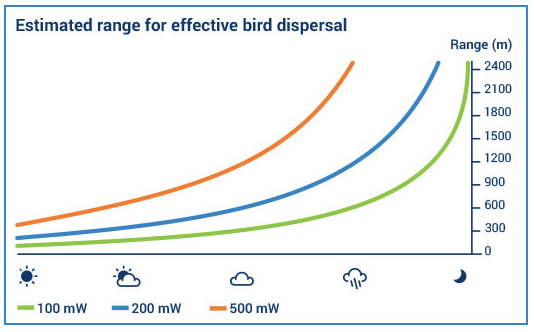
General Laser Safety Matters
Another item to also be aware of when evaluating products is to ensure they are compliant to IEC 60825-1 for general laser safety and proper classification. [20] The equivalent European standard is EN-IEC 60825-1.
At Laser Safety Certification, believe in laser safety and education. We offer laser safety courses and Laser Safety Officer certification programs to make sure your team are correctly using lasers and your customers are protected. We can help with your laser safety training needs if you are using lasers in manufacturing or production applications, or if you are using them in medical or healthcare fields and have concerns about your patient safety.
We have laser safety certification courses for Industrial, Laboratory, Veterinary, Healthcare, and Cosmetic laser users. We also have Laser Safety Officer (LSO) certification courses to help organize your company laser safety program. Our certification courses are based on the current OSHA guidelines and Technical Manual sections that apply to laser hazards and safety program. We also have laser safety kits and training bundles to help your LSO administer your own laser safety program to protect your team as well as your customers.
Click here to enroll your company to get started today. Or check out our FAQ section for common answers about our courses, certification options and kit offerings, and get started by enrolling your company today. You can always email us at info@lasersafetycertification.com if you want more information about how we can help your business use lasers safely while protecting your employees and customers.
Bird Control Product Video Examples
We have collected a representative sample of the bird control devices mentions in this story. One note we must stress is that all of these devices should be used properly such that they do not project into the air or outside of the targeted bird area, especially so that aircraft or other aerial operation are impacted.
The following is an Microbee AgriLaser product video [7] showing their handheld product disturbing nuisance birds from a building they are roosting on:
<iframe width=”560″ height=”315″ src=”https://www.youtube.com/embed/xhUp6myIHAk?si=4Xr3WV2exHuE0KM8″ title=”YouTube video player” frameborder=”0″ allow=”accelerometer; autoplay; clipboard-write; encrypted-media; gyroscope; picture-in-picture; web-share” referrerpolicy=”strict-origin-when-cross-origin” allowfullscreen></iframe>
More details on the Microbee AgriLaser can be found below [10].
The following is a video from Laser Deterrent [8] showing their handheld product working on nuisance birds in a field:
<iframe width=”560″ height=”315″ src=”https://www.youtube.com/embed/VpRtS73VnFI?si=JVoDHKdSat2Bqk05″ title=”YouTube video player” frameborder=”0″ allow=”accelerometer; autoplay; clipboard-write; encrypted-media; gyroscope; picture-in-picture; web-share” referrerpolicy=”strict-origin-when-cross-origin” allowfullscreen></iframe>
To see more of the AgriLaser approach in action, here is a video [9] using drone coverage to view the bird protection being used on a blueberry field in Florida:
<iframe width=”560″ height=”315″ src=”https://www.youtube.com/embed/clpX90KmucI?si=7Dh_cGZHn2buv5lE” title=”YouTube video player” frameborder=”0″ allow=”accelerometer; autoplay; clipboard-write; encrypted-media; gyroscope; picture-in-picture; web-share” referrerpolicy=”strict-origin-when-cross-origin” allowfullscreen></iframe>
Sources
[1] CNN, Crows in Sunnyvale: https://www.cnn.com/2022/01/16/us/california-city-using-lasers-to-move-crows-trnd/index.html
[2] ZDNet, Protecting blueberries in Oregon: https://www.zdnet.com/article/farmers-are-firing-automatic-lasers-at-hungry-birds/
[3] BirdControlGroup blog, Seagulls in Cornwall: https://www.birdcontrolgroup.com/laser-gun-used-scarecrow-21st-century-ward-seagulls/
[4] Humane Society study, What to do about crows: https://www.humanesociety.org/resources/what-do-about-crows
[5] PennState Extension Service study, Urban Crows in Pennsylvania: https://extension.psu.edu/managing-urban-crow-roosts-in-pennsylvania-and-the-northeast
[6] University of Nebraska – Lincoln study, Using Lasers to Disperse Crows: https://digitalcommons.unl.edu/cgi/viewcontent.cgi?article=1461&context=icwdm_usdanwrc
[7] AgriLaser product demo: https://www.youtube.com/watch?v=xhUp6myIHAk
[8] Laser Deterrent product demo: https://www.youtube.com/watch?v=VpRtS73VnFI
[9] CFL Drones / AgriLaser video, Protecting Blueberries in Florida: https://www.youtube.com/watch?v=clpX90KmucI
[10] Microbee AgriLaser: https://www.microbee.co.uk/bird-control/agrilaser/
[11] Wageningen University (Netherlands) study: https://www.wur.nl/en/Research-Results/Research-Institutes/Bioveterinary-Research/show-bvr/Laser-deters-wild-waterfowl-from-free-range-area-of-poultry-farm-in-fight-against-avian-influenza.htm
[12] EU CORDIS research report: https://cordis.europa.eu/article/id/421699-no-more-crop-damage-thanks-to-intelligent-laser-technology-that-keeps-pest-birds-away
[13] NPR story, Protecting blueberries in Oregon: https://www.npr.org/sections/thesalt/2018/08/12/633065620/growers-are-beaming-over-the-success-of-lasers-to-stave-off-thieving-birds
[14] Cornell Law School LII e-CFR, Title 50: https://www.law.cornell.edu/cfr/text/50/20.133
[15] American Crow Regulations synopsis: https://nrm.dfg.ca.gov/FileHandler.ashx?DocumentID=165441
[15] Bird Control Group AVIS Autonomic Mark II: https://www.birdcontrolgroup.com/automated-laser-bird-repellent/
[16] Feather Light Technologies Avian Dissuader: https://www.aviandissuader.com/
[17] Margo Supplies, How Effect are Bird Lasers? https://margosupplies.com/us-en/how-effective-are-bird-lasers/
[18] U.S. Department of Agriculture study, Use of Lasers in Avian Dispersal: https://www.dropbox.com/s/17v6a8t0ymhddq6/2003%20USDA%20APHIS%20-%20Use%20of%20Lasers%20in%20Avian%20Dispersal.pdf?dl=0
[19] U.S. Department of Agriculture publication, Evaluation of Lasers to Disperse Crows: Evaluation of lasers to disperse American Crows … from urban night roosts
[20] ANSI IEC 60825-1: https://webstore.ansi.org/Standards/IEC/iec60825ed2014?gclid=EAIaIQobChMI-OnXyMuc-QIVgwnnCh1-cAc2EAAYASAAEgKo4_D_BwE
[21] Bird Control Group FAQ: https://www.birdcontrolgroup.com/faq/
Image source: ZDNet [2]
Bird Control Product Video Examples
We have collected a representative sample of the bird control devices mentions in this story. One note we must stress is that all of these devices should be used properly such that they do not project into the air or outside of the targeted bird area, especially so that aircraft or other aerial operation are impacted.
The following is an Microbee AgriLaser product video [7] showing their handheld product disturbing nuisance birds from a building they are roosting on:
More details on the Microbee AgriLaser can be found below [10].
The following is a video from Laser Deterrent [8] showing their handheld product working on nuisance birds in a field:
To see more of the AgriLaser approach in action, here is a video [9] using drone coverage to view the bird protection being used on a blueberry field in Florida:
Sources
[1] CNN, Crows in Sunnyvale: https://www.cnn.com/2022/01/16/us/california-city-using-lasers-to-move-crows-trnd/index.html
[2] ZDNet, Protecting blueberries in Oregon: https://www.zdnet.com/article/farmers-are-firing-automatic-lasers-at-hungry-birds/
[3] BirdControlGroup blog, Seagulls in Cornwall: https://www.birdcontrolgroup.com/laser-gun-used-scarecrow-21st-century-ward-seagulls/
[4] Humane Society study, What to do about crows: https://www.humanesociety.org/resources/what-do-about-crows
[5] PennState Extension Service study, Urban Crows in Pennsylvania: https://extension.psu.edu/managing-urban-crow-roosts-in-pennsylvania-and-the-northeast
[6] University of Nebraska – Lincoln study, Using Lasers to Disperse Crows: https://digitalcommons.unl.edu/cgi/viewcontent.cgi?article=1461&context=icwdm_usdanwrc
[7] AgriLaser product demo: https://www.youtube.com/watch?v=xhUp6myIHAk
[8] Laser Deterrent product demo: https://www.youtube.com/watch?v=VpRtS73VnFI
[9] CFL Drones / AgriLaser video, Protecting Blueberries in Florida: https://www.youtube.com/watch?v=clpX90KmucI
[10] Microbee AgriLaser: https://www.microbee.co.uk/bird-control/agrilaser/
[11] Wageningen University (Netherlands) study: https://www.wur.nl/en/Research-Results/Research-Institutes/Bioveterinary-Research/show-bvr/Laser-deters-wild-waterfowl-from-free-range-area-of-poultry-farm-in-fight-against-avian-influenza.htm
[12] EU CORDIS research report: https://cordis.europa.eu/article/id/421699-no-more-crop-damage-thanks-to-intelligent-laser-technology-that-keeps-pest-birds-away
[13] NPR story, Protecting blueberries in Oregon: https://www.npr.org/sections/thesalt/2018/08/12/633065620/growers-are-beaming-over-the-success-of-lasers-to-stave-off-thieving-birds
[14] Cornell Law School LII e-CFR, Title 50: https://www.law.cornell.edu/cfr/text/50/20.133
[15] American Crow Regulations synopsis: https://nrm.dfg.ca.gov/FileHandler.ashx?DocumentID=165441
[15] Bird Control Group AVIS Autonomic Mark II: https://www.birdcontrolgroup.com/automated-laser-bird-repellent/
[16] Feather Light Technologies Avian Dissuader: https://www.aviandissuader.com/
[17] Margo Supplies, How Effect are Bird Lasers? https://margosupplies.com/us-en/how-effective-are-bird-lasers/
[18] U.S. Department of Agriculture study, Use of Lasers in Avian Dispersal: https://www.dropbox.com/s/17v6a8t0ymhddq6/2003%20USDA%20APHIS%20-%20Use%20of%20Lasers%20in%20Avian%20Dispersal.pdf?dl=0
[19] U.S. Department of Agriculture publication, Evaluation of Lasers to Disperse Crows: Evaluation of lasers to disperse American Crows … from urban night roosts
[20] ANSI IEC 60825-1: https://webstore.ansi.org/Standards/IEC/iec60825ed2014?gclid=EAIaIQobChMI-OnXyMuc-QIVgwnnCh1-cAc2EAAYASAAEgKo4_D_BwE
[21] Bird Control Group FAQ: https://www.birdcontrolgroup.com/faq/
Image source: ZDNet [2]
